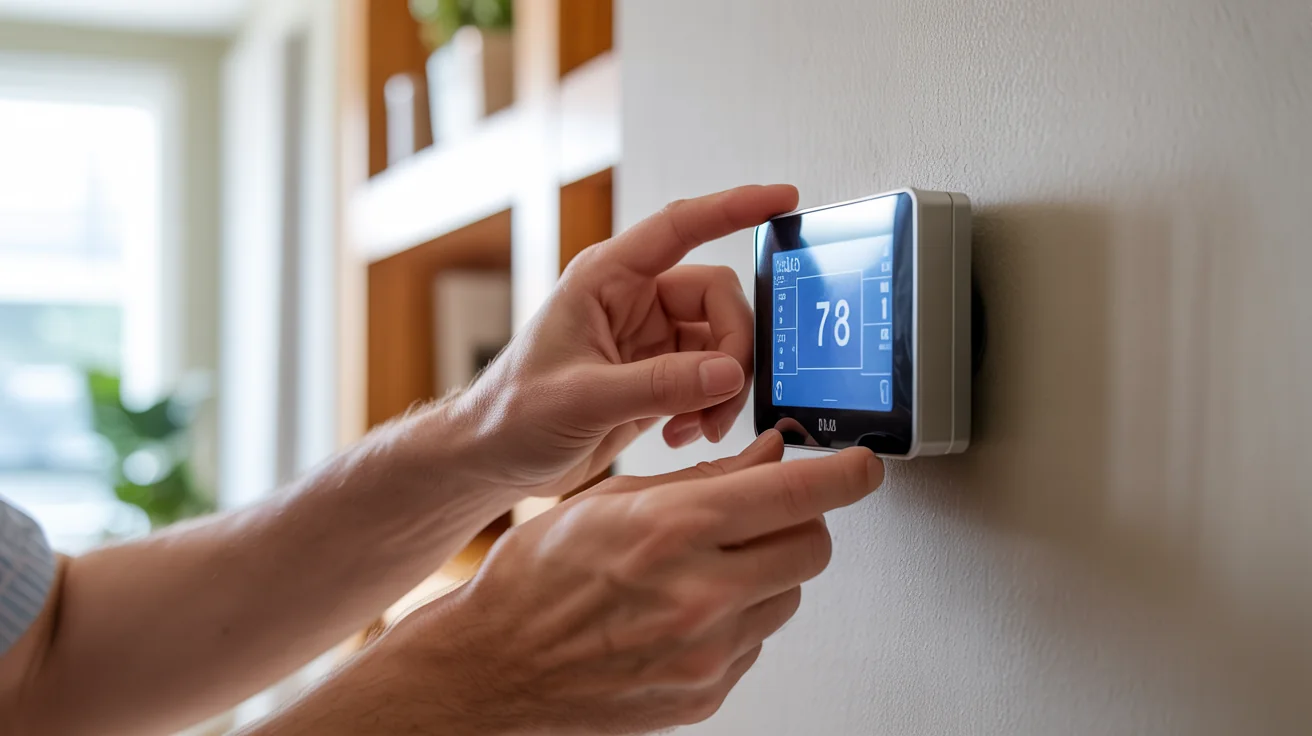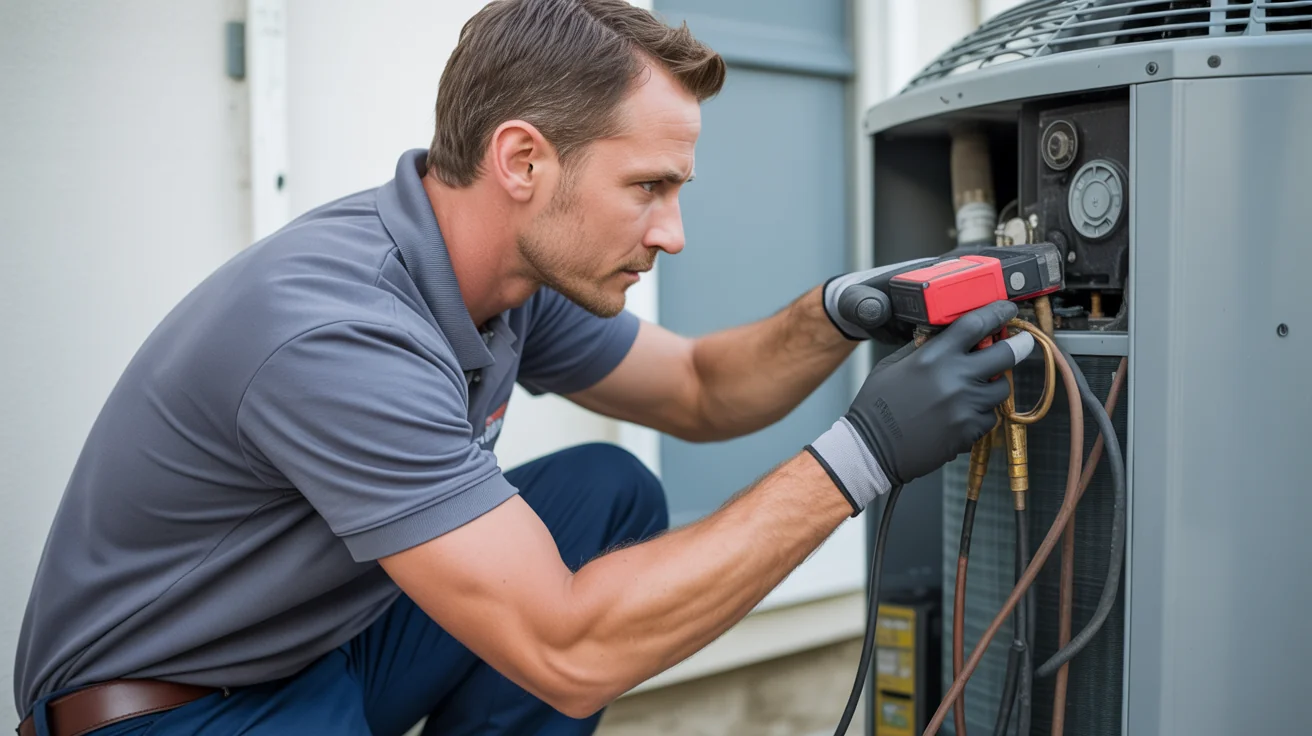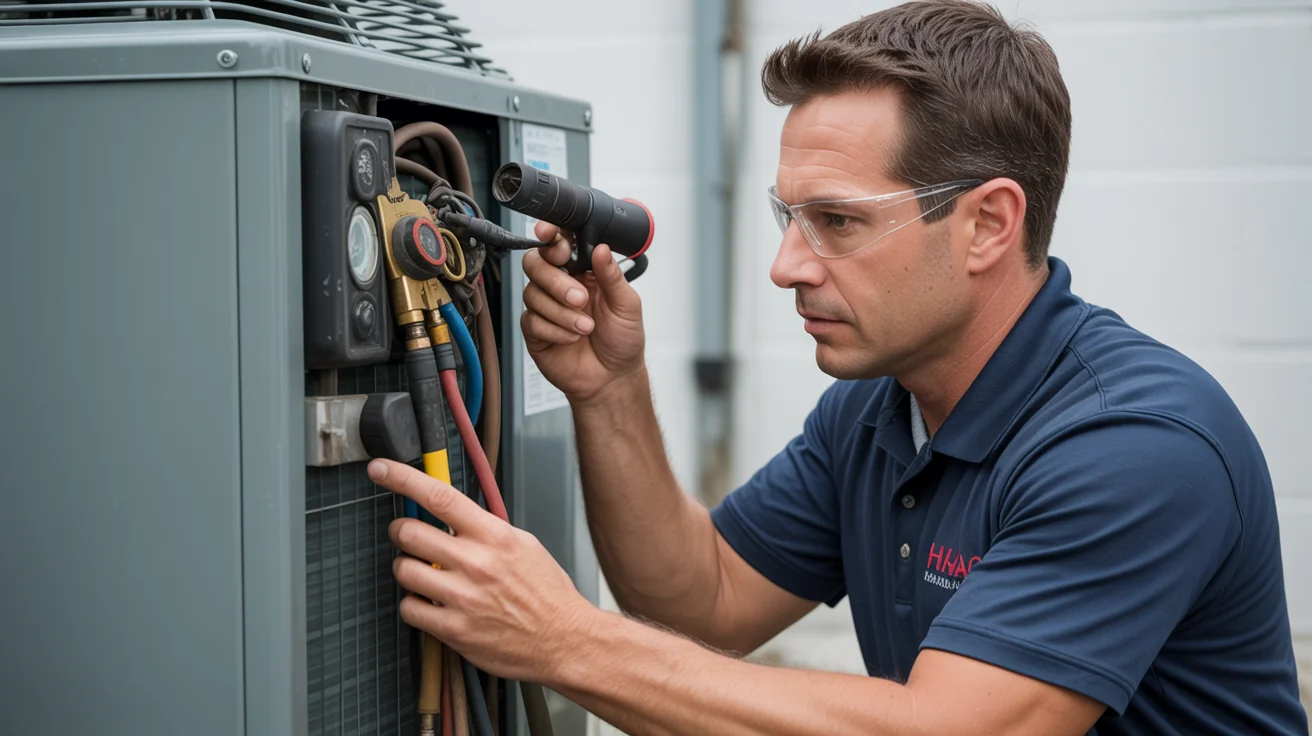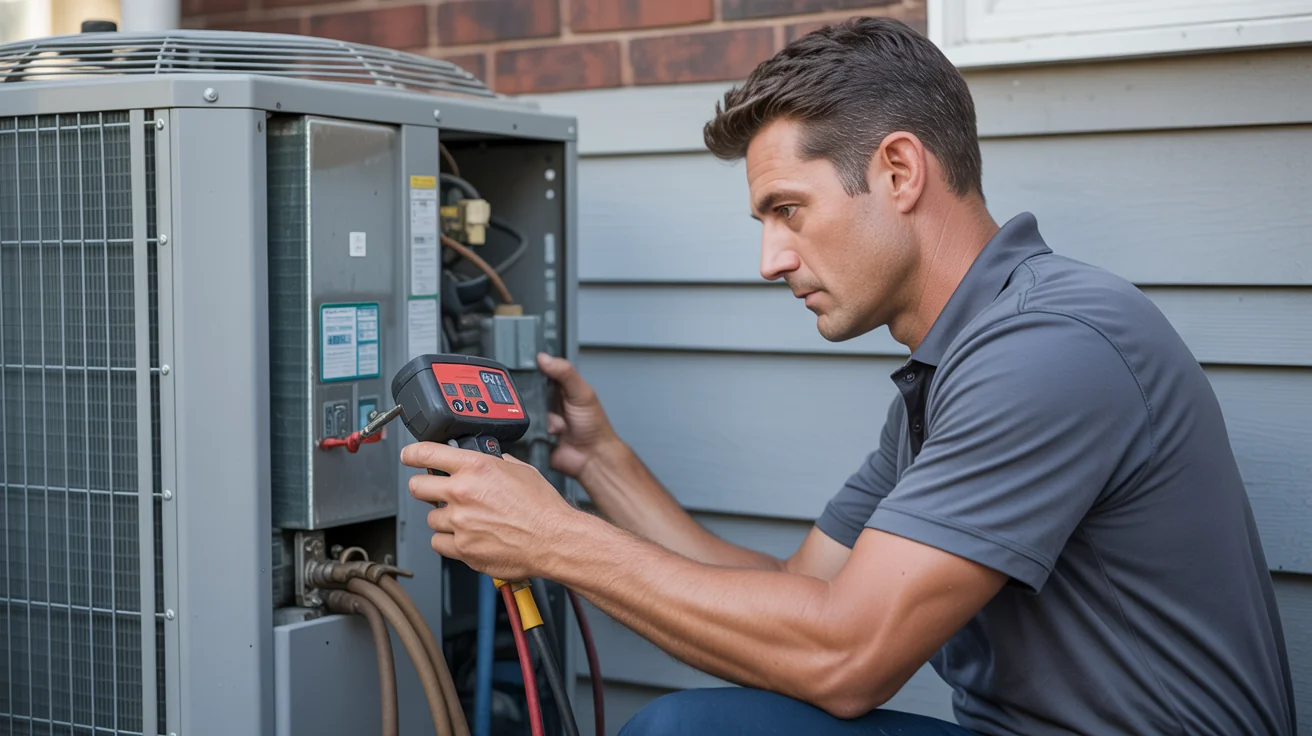HVAC Energy Efficiency Tips North Texas Winter 2025: Complete Savings Guide
Complete North Texas winter HVAC energy efficiency guide covering heating optimization, cost reduction strategies, smart controls, and professional maintenance.

- Winter Energy Efficiency Strategies for North Texas HVAC
- Why North Texas Winter Demands Energy Efficiency Focus
- Understanding North Texas Winter Heating Costs
- Thermostat Optimization for North Texas Winter
- Heat Pump Optimization for North Texas Climate
- Insulation and Air Sealing Strategies
- Maintenance for Peak Winter Efficiency
- Cost-Effective Winter Energy Improvements
+ 4 more sections below...
- Winter Energy Efficiency Strategies for North Texas HVAC
- Why North Texas Winter Demands Energy Efficiency Focus
- Understanding North Texas Winter Heating Costs
- Thermostat Optimization for North Texas Winter
- Heat Pump Optimization for North Texas Climate
- Insulation and Air Sealing Strategies
- Maintenance for Peak Winter Efficiency
- Cost-Effective Winter Energy Improvements
+ 4 more sections below...
Winter Energy Efficiency Strategies for North Texas HVAC
Related: Energy Efficiency
This North Texas winter story blew my mind: The Chen family in McKinney got absolutely hammered with an $1,850 energy bill during February’s brutal cold snap. Their 2,800 sq ft home was bleeding money as their old system fought desperately against those 15°F nights.
What happened next shocked even me after 15 years in this business.
We started with a smart thermostat - proper programming and learning their patterns cut runtime by 23%. But the real game-changer was fixing their ductwork. Those ducts were hemorrhaging heated air into the attic and crawl space, wasting 35% of every dollar they spent on heating. Then we cleaned and tuned their heat pump - the outdoor coils were so filthy they could barely function, which improved efficiency by 28%. Finally, we hit the worst insulation weak spots that thermal imaging revealed, cutting heat loss by another 19%.
The incredible result: Their next winter’s highest bill was just $680 - a whopping $1,170 monthly savings that paid for every single improvement in just 3.2 months.
Here’s the North Texas reality: Basic energy efficiency fixes can slash your winter heating costs by 40-60%, but 84% of homeowners are still throwing away $800-2,100 every year on completely preventable waste.
🚨 Ready for dramatic winter energy savings? Call Jupitair HVAC at (940) 390-5676 for your complete energy efficiency assessment and optimization across North Texas.
Why North Texas Winter Demands Energy Efficiency Focus
North Texas’s unique winter climate creates specific energy challenges that require targeted efficiency strategies:
What North Texas Winter Actually Does to Your Energy Bills
Variable temperatures ranging from 65°F days to 15°F nights within single weeks means your heating system is constantly adjusting, starting up, shutting down, and starting up again. That constant cycling is murder on efficiency and equipment life. Humidity fluctuations affect comfort and heating efficiency in ways most homeowners don’t realize - dry winter air makes 70°F feel like 65°F, so people crank up the heat unnecessarily. Wind exposure in suburban and rural areas increases heat loss dramatically, especially on those windy winter nights when it feels like the cold is trying to break down your front door. Urban heat islands create temperature variations across the metroplex, so what works in downtown Dallas might not be optimal for a home in rural Collin County.
Energy Cost Factors:
Time-of-use electricity rates create peak pricing during morning and evening heating periods when families need the most comfort. Grid stress events during extreme cold weather drive energy costs even higher when heating demand spikes across the metroplex. Heat pump efficiency variations create dramatic performance changes across temperature ranges, meaning your system costs far more to operate when you need it most. Heating system cycling with frequent on/off operation reduces efficiency significantly, wasting energy with every startup cycle.
Understanding North Texas Winter Heating Costs
Energy Consumption Patterns
Typical North Texas Winter Energy Use:
Heating dominance accounts for 60-75% of winter energy costs from space heating alone, making efficient heating systems critical for cost control. Hot water impact represents 15-20% of winter energy use, with increased usage during cold weather for showers, laundry, and cleaning. Electrical baseload from lights, appliances, and electronics makes up 10-15% of usage but increases during winter months with longer nights and more indoor activity. Peak demand charges add additional costs during high-usage periods when everyone’s heating systems kick on simultaneously.
Cost Breakdown by Home Size:
Smaller 1,500 square foot homes typically see $180-350 monthly winter heating costs, though these can spike during severe cold snaps. Moderate 2,500 square foot homes experience $280-550 monthly costs during peak winter periods, with the wide range reflecting insulation quality and system efficiency. Large 3,500+ square foot homes face $420-850 monthly heating bills, making efficiency improvements absolutely critical for budget management. Efficiency improvements can deliver 40-60% cost reductions with complete optimization, transforming winter bills from budget-busters into manageable expenses.
Time-of-Use Rate Impact
Peak Heating Hour Costs:
Morning peak hours from 6-9 AM create the highest electricity rates during startup heating demand when everyone’s getting ready for work and school. Evening peak periods from 5-8 PM establish secondary peak pricing during family activity when everyone returns home and cooking begins. Overnight rates offer the lowest costs during reduced occupancy when many families are sleeping under blankets and don’t need full heating. Weekend variations create different patterns affecting heating costs, often with shifted peak periods that smart homeowners can exploit for savings.
Strategic Rate Management:
Pre-heating strategies involve warming homes during off-peak periods when electricity rates are lowest, storing heat in the home’s thermal mass for later use. Temperature setback reduces heating during peak rate hours, allowing families to coast on stored heat while avoiding the highest electricity costs. Thermal mass utilization takes advantage of the home’s natural heat storage capacity during low-rate periods, banking warmth for when rates spike. Smart scheduling optimizes heating operation around rate structures, automatically adjusting system operation to minimize costs while maintaining comfort.
Maximizing Your Electricity Savings: Beyond HVAC efficiency, North Texas homeowners can achieve additional savings by comparing Texas electricity rates to make sure they’re getting the best available rate plan for their usage patterns. With deregulated electricity markets in Texas, finding the right rate structure can complement your HVAC efficiency improvements for maximum winter energy savings.
Thermostat Optimization for North Texas Winter
Smart Thermostat Programming
Optimal Winter Programming:
Weekday schedules should maintain 68°F when occupied, drop to 62°F when away, and settle at 65°F for comfortable sleep without overheating bedrooms. Weekend schedules require adjustment for different occupancy patterns when families stay home longer and have more flexible routines. Setback timing works best when programmed 30-45 minutes before departure with gradual recovery beginning before family members return. Recovery programming starts heating early enough to achieve desired comfort without waste, avoiding the common mistake of cranking up the temperature for faster heating.
Advanced Programming Features:
Learning algorithms automatically adapt to household patterns, studying when family members come and go to optimize heating without manual programming. Weather integration adjusts operation based on outdoor conditions, pre-heating before cold fronts or scaling back when temperatures moderate unexpectedly. Geofencing technology automatically adjusts temperature settings when family members leave or return, using smartphone location data to maximize comfort and efficiency. Energy usage tracking monitors consumption patterns for continuous optimization, identifying opportunities to reduce costs without sacrificing comfort.
Manual Thermostat Strategies
Efficient Manual Operation:
Consistent settings avoid frequent temperature changes that force the heating system to work harder and waste energy with constant adjustments. Reasonable comfort levels maintain 68-70°F when occupied and 62-65°F when unoccupied, balancing comfort with energy savings. Gradual adjustments of 2°F maximum prevent system stress that occurs when demanding large temperature changes quickly. Nighttime setback with 5-8°F reductions during sleeping hours takes advantage of natural comfort preferences under blankets while saving significant energy.
Common Thermostat Mistakes:
Cranking up the temperature to 80°F doesn’t make the home heat any faster - it just wastes energy by overshooting the desired temperature. Frequent adjustments reduce efficiency as the system constantly struggles to reach new setpoints instead of maintaining steady operation. Extreme setbacks create large temperature swings that stress systems and often waste more energy during recovery than they save during setback periods. Poor timing like heating empty homes or running heating systems during peak electricity pricing periods throws money away unnecessarily.
Heat Pump Optimization for North Texas Climate
Heat Pump Efficiency Maximization
Temperature-Based Operation:
Heat pumps operate most efficiently between 25-50°F outdoor temperatures, delivering excellent heating performance while consuming minimal electricity. Auxiliary heat management focuses on minimizing backup electric heat use, which can cost 2-3 times more than heat pump operation. Defrost cycle optimization ensures proper operation during humid conditions when ice buildup on outdoor coils reduces performance. Professional calibration sets switching points for maximum efficiency, determining exactly when to engage backup heat versus running the heat pump at lower efficiency levels.
Cold Weather Performance:
Cold-climate heat pumps deliver enhanced performance below 20°F, using advanced refrigerants and compressor technology to extract heat from even very cold air. Backup heat coordination ensures seamless switching during extreme cold, activating auxiliary heating exactly when needed without gaps in comfort. Maintenance importance becomes critical in cold weather, as clean coils are crucial for maintaining efficiency when systems work hardest. Refrigerant optimization with proper charge levels maintains performance throughout the operating range, preventing efficiency losses during the coldest periods.
Dual-Fuel System Benefits
Optimal Fuel Switching:
Heat pump primary operation uses electric heating during moderate temperatures when heat pumps operate at peak efficiency and cost-effectiveness. Gas furnace backup switches operation during extreme cold weather or when economic conditions favor gas over electricity. Automatic switching employs smart controls that continuously determine the most efficient operation based on outdoor temperature, energy costs, and system performance. Cost optimization balances electric and gas costs for minimum expenses, automatically selecting the most economical heating source for current conditions.
North Texas Dual-Fuel Advantages:
Our mild winter climate allows heat pump efficiency throughout most of the season, with average winter temperatures well within optimal heat pump operating ranges. Occasional extreme cold periods benefit from gas backup during brief cold snaps when heat pump efficiency drops or demand exceeds capacity. Utility rate arbitrage enables using the cheapest fuel source at any time, automatically switching based on real-time energy pricing. System redundancy provides backup heating if either system fails, ensuring families never lose heating capability during equipment problems.
Insulation and Air Sealing Strategies
Critical Insulation Areas
Attic Insulation Priority:
R-38 insulation represents the minimum recommended for North Texas climate, typically requiring 12-15 inches of fiberglass insulation for adequate thermal protection. R-49 insulation provides maximum efficiency with 15-18 inches of properly installed insulation, delivering superior energy savings that justify the additional investment. Air sealing must come first before adding insulation for maximum effectiveness, as air leaks can bypass insulation and waste significant energy. Professional installation ensures complete coverage and proper ventilation, preventing moisture problems while maximizing thermal performance.
Wall Insulation Considerations:
Existing home challenges make retrofitting walls difficult and expensive compared to other efficiency improvements, often requiring opening walls or accessing cavities from outside. Blown-in insulation options allow adding insulation to existing wall cavities through small holes, providing improved thermal performance without major renovation disruption. Exterior insulation systems wrap homes during siding replacement projects, creating continuous thermal barriers that eliminate thermal bridging. Cost-benefit analysis helps prioritize highest-impact improvements, ensuring homeowners invest in upgrades that deliver the greatest energy savings per dollar spent.
Air Sealing Priorities
Major Leak Sources:
Attic access points including pulldown stairs, electrical penetrations, and ductwork connections create significant air leakage that bypasses insulation completely. Basement and crawlspace areas develop leaks around rim joists, foundation penetrations, and access doors that allow conditioned air to escape and outside air to enter. Windows and doors require properly maintained weather stripping, caulking, and potentially storm doors to prevent infiltration around these large openings. Electrical outlets on exterior walls benefit from foam gaskets behind outlet covers, sealing small but numerous penetrations that collectively waste significant energy.
DIY Air Sealing Projects:
Caulk application seals gaps around windows, doors, and penetrations using appropriate caulk types for each location and weather condition. Weatherstripping installation creates tight seals around doors and windows, using high-quality materials that withstand North Texas temperature variations. Outlet gaskets provide foam seals behind electrical outlets and switches on exterior walls, addressing small but numerous air leakage points. Attic air sealing uses foam sealant around penetrations and gaps before insulation installation, creating an effective air barrier that prevents conditioned air from escaping into unconditioned spaces.
Professional Energy Audit Benefits
Comprehensive Assessment: Blower door testing: measuring whole-house air leakage. Thermal imaging: identifying hidden insulation gaps and air leaks. Duct leakage testing: measuring distribution system efficiency. Energy modeling: predicting savings from various improvements.
Prioritized Improvement Plans: Cost-benefit analysis: ranking improvements by return on investment. Utility rebate coordination: maximizing available incentive programs. Professional installation: ensuring proper technique for maximum benefit. Performance verification: confirming improvements deliver projected savings.
Ductwork Efficiency and Maintenance
Duct Sealing Benefits
Need repairs? Check out our Duct Sealing solutions.
Energy Loss Prevention: 30-40% energy loss typical in unsealed duct systems. Immediate savings from professional duct sealing. Comfort improvement eliminating hot and cold spots. Equipment protection reducing system stress from air loss.
Professional Duct Sealing Process: Duct leakage testing: measuring current system efficiency. Access evaluation: determining sealing approach for ductwork. Mastic application: professional sealing materials and techniques. Performance verification: confirming leakage reduction and efficiency gain.
Ductwork Maintenance
Regular Ductwork Care: Visual inspection: checking accessible ductwork for damage or separation. Insulation verification: ensuring ductwork insulation remains intact. Support checking: verifying ducts remain properly supported. Professional assessment: periodic professional ductwork evaluation.
Efficiency-Focused Maintenance: Register cleaning: ensuring unobstructed airflow through vents. Return air pathway: maintaining clear air return passages. Filter replacement: regular filter changes maintaining system airflow. Professional cleaning: periodic ductwork cleaning improving efficiency.
Smart Home Integration for Energy Savings
Advanced Control Systems
Smart Home Energy Management: Occupancy sensors: automatically adjusting heating based on room use. Zone control systems: heating only occupied areas of homes. Smart vents: automatically redirecting airflow to needed areas. Energy monitoring: real-time tracking of heating system energy use.
Integration Benefits: Automated efficiency: systems optimizing themselves without user intervention. Usage visibility: understanding energy consumption patterns. Remote control: managing heating systems from anywhere. Predictive operation: systems learning and anticipating needs.
Utility Integration
Demand Response Programs: Grid peak reduction: earning credits for reducing heating during peak periods. Pre-heating strategies: using off-peak energy to warm homes before peak rates. Utility communication: systems responding to grid conditions automatically. Cost optimization: continuously minimizing energy costs through smart operation.
Time-of-Use Optimization: Rate schedule programming: automatically adjusting operation for lowest rates. Thermal mass utilization: using home’s heat storage during low-rate periods. Peak avoidance: reducing heating during highest-cost periods. Energy storage: using home as thermal battery during rate optimization.
Maintenance for Peak Winter Efficiency
Pre-Winter System Preparation
Professional Fall Tune-Up: Heating system cleaning: removing debris and buildup from components. Safety inspection: verifying carbon monoxide safety and gas connections. Efficiency testing: measuring actual system performance. Control calibration: optimizing thermostat and system controls.
Filter Management: High-efficiency filters: installing merv 11-13 filters for winter operation. Regular replacement: monthly changes during heavy use periods. Filter selection: balancing air quality with system airflow needs. Professional consultation: optimizing filtration for specific systems.
Ongoing Winter Maintenance
Monthly Winter Tasks: Filter inspection: checking filter condition and replacing as needed. System observation: listening for unusual sounds or performance changes. Thermostat verification: ensuring accurate temperature control. Vent inspection: keeping heating vents unobstructed.
Professional Winter Support: Emergency availability: 24/7 service during extreme weather. Performance monitoring: tracking system efficiency throughout winter. Problem prevention: identifying issues before they become expensive. Optimization opportunities: continuous efficiency improvement recommendations.
Cost-Effective Winter Energy Improvements
Low-Cost High-Impact Improvements ($25-200)
Immediate Efficiency Gains: Programmable thermostat: $50-150 for basic models with significant savings. Air sealing supplies: $25-75 for caulk, weatherstripping, foam sealant. Outlet gaskets: $10-25 for whole-house electrical outlet sealing. Draft stoppers: $15-40 for door and window draft elimination.
DIY Implementation: Weekend projects: most improvements completed in 1-2 days. Basic tools required: simple hand tools for most projects. Immediate results: savings visible on next energy bill. Professional guidance: hvac experts available for consultation.
Medium Investment Improvements ($200-1,000)
Smart Technology Upgrades: Smart thermostats: $200-400 for advanced models with learning capabilities. Zone control additions: $300-800 for basic zoning in existing systems. Duct sealing: $400-800 for professional whole-house duct sealing. Insulation additions: $500-1,000 for attic insulation upgrades.
Professional Installation Benefits: Quality assurance: proper installation ensuring maximum benefit. Warranty protection: professional work warranties protecting investment. Code compliance: meeting all safety and building needs. Performance optimization: expert setup maximizing efficiency gains.
Major Efficiency Investments ($1,000-5,000)
System Upgrades: High-efficiency heating equipment: $2,500-5,000 for premium systems. Heat pump installations: $3,000-8,000 for new heat pump systems. Whole-house energy improvements: $2,000-5,000 for complete upgrades. Smart home integration: $1,500-4,000 for complete automation.
Return on Investment: Energy savings: $400-1,200 annual savings from major improvements. Payback periods: 3-8 years for most major efficiency investments. Home value increase: $2,000-8,000 added value from efficiency improvements. Comfort benefits: improved year-round comfort and air quality.
Regional Winter Efficiency Strategies
North Dallas County Optimization
Urban Heat Island Benefits: Milder temperatures: reduced heating needs in urban cores. Heat pump advantages: extended efficient operation range. Grid access: better utility program availability and competitive rates. Professional services: greater access to efficiency contractors and services.
Collin County Rural Areas
Rural Heating Challenges: Greater exposure: higher heat loss from wind and open areas. Propane heating: different fuel cost considerations and efficiency strategies. Limited utility options: fewer energy provider choices and programs. Professional access: ensuring adequate contractor availability.
Rural Optimization Strategies: Enhanced insulation: higher r-values for greater exposure conditions. Wind protection: landscaping and barriers reducing heat loss. Fuel flexibility: dual-fuel systems managing propane and electric costs. Emergency preparedness: backup heating during utility outages.
Professional Energy Efficiency Services
Comprehensive Energy Assessment
Professional Evaluation Process: Home energy audit: complete assessment of efficiency opportunities. Performance testing: measuring actual system efficiency and capacity. Cost-benefit analysis: prioritizing improvements by return on investment. Implementation planning: phased approach managing budget and disruption.
Assessment Benefits: Expert analysis: professional identification of efficiency opportunities. Utility rebate coordination: maximizing available incentive programs. Performance verification: confirming improvements deliver projected savings. Ongoing support: continued optimization and maintenance recommendations.
Professional Implementation
Installation and Optimization: Quality workmanship: professional installation ensuring maximum efficiency. System integration: coordinating multiple improvements for optimal results. Performance verification: testing and commissioning ensuring proper operation. Customer education: training homeowners on efficient operation techniques.
Ongoing Support: Performance monitoring: tracking actual savings and system performance. Maintenance coordination: preserving efficiency through proper care. Technology updates: incorporating new efficiency technologies as available. Continuous improvement: identifying additional opportunities over time.
Frequently Asked Questions
How much can I save on winter heating bills in North Texas?
Potential savings vary by home and current efficiency: Basic improvements: 15-25% savings from thermostat programming and air sealing. Comprehensive improvements: 40-60% savings from multiple efficiency measures. Professional optimization: 30-50% savings from system tune-ups and repairs. System upgrades: 50-70% savings from high-efficiency equipment replacement.
Typical North Texas homes save $300-1,200 annually with complete efficiency improvements.
What’s the most cost-effective winter energy improvement?
High-impact, low-cost improvements include: Programmable thermostat: $50-150 investment, 10-15% savings potential. Air sealing: $25-100 in materials, 10-20% savings potential. Filter maintenance: $50-100 annually, 5-10% efficiency improvement. Professional tune-up: $150-250, 15-25% efficiency improvement.
Professional assessment identifies highest-impact opportunities for your specific home.
Should I use a programmable or smart thermostat in North Texas?
Thermostat choice depends on lifestyle and goals: Programmable thermostats: effective for consistent schedules, lower cost. Smart thermostats: better for variable schedules, maximum savings potential. Learning thermostats: ideal for busy families with changing routines. Professional installation: ensures optimal programming and performance.
Smart thermostats typically provide 10-23% additional savings over basic programmable models.
How do I know if my heating system is operating efficiently?
Efficiency indicators include: Energy bills: comparing current bills to previous years and similar homes. Comfort consistency: even temperatures throughout home without hot/cold spots. System cycling: appropriate run times without excessive short cycling. Air quality: clean air without dust or odor issues.
Professional assessment measures actual efficiency and identifies improvement opportunities.
Are heat pumps efficient for North Texas winters?
Heat pumps work well in North Texas climate: Efficient temperature range: most north texas winter days ideal for heat pump operation. Mild winter climate: average temperatures well within efficient operation range. Backup heat availability: gas furnace or electric backup for extreme cold days. Cost effectiveness: lower operating costs than electric furnaces or older gas systems.
Professional evaluation figure outs heat pump suitability for your specific home and situation.
When should I consider professional energy efficiency services?
Professional services benefit homeowners with: High energy bills: costs exceeding $200-300 monthly during winter. Comfort problems: uneven temperatures or difficult-to-heat areas. Old equipment: systems over 10-15 years old with declining efficiency. Home improvements: major renovations affecting heating needs.
Professional assessment typically pays for itself through identified savings opportunities.
Maximize Your Winter Energy Savings
Turn your North Texas home into an energy-saving machine with professional help from Jupitair HVAC. Our complete approach to winter efficiency delivers massive savings while keeping you perfectly comfortable all season long.
Why Work With Jupitair for Winter Energy Efficiency: 15+ years North Texas experience - we know every trick our climate throws at you. Complete efficiency assessment - we find every penny you’re wasting. Professional installation and tuning - maximum benefit from every improvement. Ongoing support and monitoring - peak efficiency all winter and beyond.
Ready for dramatic winter energy savings? Call (940) 390-5676 or contact us online for your complete energy efficiency assessment and optimization service.
Stop wasting money on inefficient winter heating. Professional energy efficiency improvements pay for themselves while keeping your North Texas home comfortable all winter long.
Need Professional HVAC Service?
Our certified technicians are ready to help with any HVAC needs in North Texas




